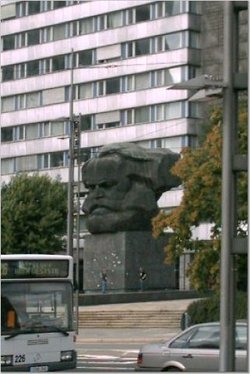Chemnitz
|
|
Chemnitz-Position.png
Chemnitz (Sorbian/Lusatian Kamjenica, formerly called Karl-Marx-Stadt) is a city in Saxony, Germany. It is located in the northern foothills of the Ore Mountains. The city has a population of 247,723 (as of 2003), and an area of 220.8 km².
The city is the third largest in Saxony. It is named after the Chemnitz River, a small tributary of the Zwickauer Mulde River. The word "Chemnitz" is from the Sorbian language and means "stony brook".
Chemnitz has one sister city, Akron, Ohio, United States.
| Contents |
History
In 1143 there was a Benedictine monastery at the place where the city now is. A settlement grew around the monastery and about 1170 Frederick I, Holy Roman Emperor granted it the rights of an imperial city. In 1307 the town became subordinate to the margravate of Meissen (which was the predecessor of the Saxon state). In medieval times Chemnitz became a centre of textile production and trade. More than one third of the population worked in textile production. This continued through the industrial revolution: factories were established, and by the early 19th century Chemnitz had become an industrial centre (sometimes called "the Saxon Manchester"). In 1913 Chemnitz had a population of 320,000 and is one of very few cities which were larger at that time than they are today.
In World War II the factories of Chemnitz produced mainly goods for the military. As a consequence, the city was heavily bombed and almost entirely destroyed.
The East German government decided to turn Chemnitz into a socialist model city. Boroughs full of concrete slab buildings were erected around the city centre, and few of the pre-war buildings were restored. In 1953 Chemnitz was renamed to Karl-Marx-Stadt ("Karl Marx City"). It returned to the original name of Chemnitz on 21 June 1990.
Sights
Due to the Stalinist planning of the 1950s there are few sights, although there has been much restoration of old buildings after the German reunification. There is still a giant monumental bronze bust of Karl Marx.
Other sights include the Old Town Hall with its Renaissance portal (15th century), the Red Tower (12th century) and the castle on the land of the former monastery.
A very interesting sight is the petrified forest which you can find in the courtyard of "Kulturkaufhaus Tietz". It is one of a very few in existence and dates back several million years.
Also within the city limits, in the district of Rabenstein, you can find the smallest castle of Saxony, which is called Burg Rabenstein. It is in an idyllic setting and is the perfect place to take a little walk.
Pronunciation
In the German language, "Chemnitz" is pronounced "KEM-nits" (IPA: [ʹkɛmnıts]).
External links
- Official website (http://www.chemnitz.de) (German, English)cs:Saská Kamenice
de:Chemnitz da:Chemnitz eo:Chemnitz fr:Chemnitz it:Chemnitz nl:Chemnitz no:Chemnitz pl:Chemnitz pt:Chemnitz ru:Хемниц sv:Chemnitz

